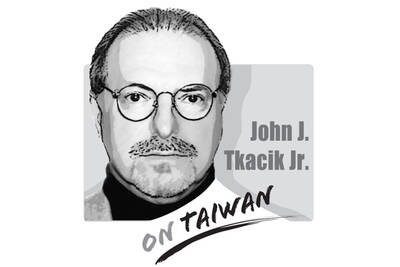In front of a large crowd at a news conference during last week’s Chinese National People’s Congress and Chinese People’s Political Consultative Conference — an annual gathering of the Chinese government known as the “two sessions” — Chinese Minister of Foreign Affairs Wang Yi (王毅) spoke about UN Resolution 2758.
Wang claimed that the resolution granted Beijing “the right to represent China,” and even proudly boasted that “the only official name for Taiwan recognized by the UN is Taiwan Province, China.”
The former statement is true, but the latter is the result of China buying influence over the UN. The first UN yearbook is proof of this. In 1947, Taiwan was technically still under Japan’s control, as the formal legal transfer of Taiwan’s sovereignty after World War II was still pending. Despite this, the 1946-1947 UN yearbook recorded “Formosa” as part of China’s territory. There is no other explanation for this other than that China had bought out the UN.
It was not until June 20, 1949, that the truth was revealed. Chiang Kai-shek (蔣介石) fled to Taiwan after the Chinese Nationalist Party’s (KMT) defeat by the Chinese Communist Party (CCP). Overcome with anxiety, Chiang sent a telegram to US general Douglas MacArthur — the supreme commander of the Allied Powers in the Far East at the time — pleading for assistance. In his message, Chiang requested he and the Republic of China (ROC) government be allowed to remain in Taiwan temporarily, as he and MacArthur opposed the spread of communism.
Chiang promised that the ROC would not permanently relocate its capital to Taiwan or seek exile there. This telegram was partially hidden from the Academia Historica Office and the KMT archives by former director of the National Palace Museum Chin Hsiao-yi (秦孝儀) to deceive the public.
Chiang’s promise not to permanently move the capital to Taiwan or go into exile demonstrates that he knew deep down that Taiwan did not belong to the ROC, and that the Cairo Declaration did not explicitly and legally grant the ROC sovereignty over Taiwan.
Wang also brought up the so-called legal basis for Taiwan’s “return” to China, claiming it was clearly stipulated in the Cairo Declaration. However, this is simply another one of Wang’s lies. Aside from the telegram from Chiang to MacArthur, which acknowledged that Taiwan did not belong to the ROC, then-US president Franklin D. Roosevelt and then-British prime minister Winston Churchill had reservations about China’s annexation of Taiwan. Therefore, the Cairo Declaration merely listed the return of Taiwan to China as a common “purpose” of the three countries — it was not a legal stipulation.
On Dec. 24, 1943, Roosevelt stated in one of his “fireside chats” — a series of 31 evening radio addresses — that one of the principles discussed with Chiang in Cairo was “the recognition of the rights of millions of people in the Far East to build up their own forms of self-government without molestation.”
Churchill, on the other hand, argued that Japan should give up control over Taiwan. Churchill also reiterated at a session of the UK Parliament on Feb. 1, 1955, that the Cairo Declaration was “merely a statement of common purpose” and that the San Francisco Peace Treaty signed in 1952 — also known as the Treaty of Peace with Japan — left the future of Taiwan’s sovereignty “undetermined.” This evidence can be accessed anywhere.
Wang’s tactics only succeed in deceiving ignorant reporters.
Sim Kiantek is a former associate professor of business administration at National Chung Hsing University.
Translated by Kyra Gustavsen
A 50-year-old on Wednesday last week died while under anesthesia at a Taipei cosmetic clinic shortly after undergoing a penis enlargement procedure. The surgeon was arrested for suspected medical malpractice, again bringing to the surface shortcomings in the regulation of cosmetic medicine. Media reports said the clinic owner and surgeon, surnamed Ting (丁), was previously convicted of negligent homicide for a postsurgical death and had been charged with coercion and aggravated assault after allegedly stopping a patient from calling for an ambulance. He had also been fined for failing inspections and had allegedly permitted people without medical licenses to assist

It was most annoying last week to read Chairman Xi Jinping’s (習近平) fulsome encomium to the People’s Liberation Army during the Eightieth Anniversary celebrations of victory over Japan in World War II. Comrade Xi’s soaring rhetoric was stuffed with “martyrs, sacrifice, solemnity and unwavering resolve” in praise of the “Chinese People’s War of Resistance Against Japanese Aggression and the World Anti-Fascist War.” His aspirations overflowed with “world peace” and love of the United Nations, of which China is a founding member. The Liberation Army Daily said that every word from General Secretary Xi Jinping “resounded in his powerful voice, illuminating the
OpenAI CEO Sam Altman recently sat down for an interview with former Fox News host Tucker Carlson in which he openly acknowledged that ChatGPT’s model behavior is indeed influencing the entire world, and that he himself is responsible for the decisions related to the bot’s moral framework. He said that he has not had a good night of sleep since its launch, as the technology could bring about unpredictable consequences. Although the discussion took place in the US, it is closely related to Taiwan. While Altman worries about the concentration of power, the Chinese Communist Party (CCP) has already weaponized artificial
When a Reuters reporter asked Chinese Ministry of Foreign Affairs spokesman Lin Jian (林劍) about Minister of Foreign Affairs Lin Chia-lung’s (林佳龍) European tour, Lin Jian expressed displeasure, referring to Lin Chia-lung as “merely a local foreign affairs official in China,” and reiterating the Chinese Communist Party’s (CCP) oft-used claim that Taiwan is a Chinese “province.” This response is a political falsehood. Although such statements have become standard fare in the CCP’s external messaging, they expose its deepest anxieties. The CCP fears confronting international reality and is even unnerved by the prospect of Taiwan’s subjectivity on the world stage. The CCP